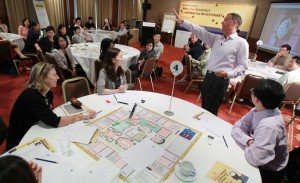Slaying the ‘creativity-killers’ (South China Morning Post)
By Nick Walker (South China Morning Post / Hong Kong)
 To employ an oft-used term from his native Australia, Andrew Grant “rocked up” into Hong Kong last month, impressing the audience at the “Who Killed Creativity?” seminar – co-sponsored by Classified Post and China Speakers Agency – where he proved the veracity of the findings of his just-published book, Who Killed Creativity?
To employ an oft-used term from his native Australia, Andrew Grant “rocked up” into Hong Kong last month, impressing the audience at the “Who Killed Creativity?” seminar – co-sponsored by Classified Post and China Speakers Agency – where he proved the veracity of the findings of his just-published book, Who Killed Creativity?
Both the book and the “roadshow” are captivating. Grant has star quality and he uses it positively. Restoring creativity to the workplace is his current mission – and that was the shared objective of those attending the fun-packed workshop.
Employing the approach and methodology of the board-game Cluedo, the question was tackled with vigour. It was like being in class with your favourite teacher at school, the one who wanted to see you have fun, knowing it nurtures thinking and results.
Grant has worked on leadership and team development around the globe for more than 15 years, but his presentation still yielded the bravado of youth, nicely seasoned with the wisdom of a recognised leader in his field. He’s young at heart, and ferociously clever with it. Indeed, one of the first things he explained was how schooling tends to stifle creativity; it’s something we lose as we get older.
 Grant’s big idea was to develop a Crime Scene Investigation-style probe into “who killed creativity”. And like all such scenarios, real and fictive, it had many dimensions and suspects.
Grant’s big idea was to develop a Crime Scene Investigation-style probe into “who killed creativity”. And like all such scenarios, real and fictive, it had many dimensions and suspects.
Grant came up with some promising profiles of the faceless assassin, or packs of assassins.
These profiles were based on his surveys of thousands of workshop participants from a range of backgrounds and experiences over more than 20 years. And, as the speaker said: “By recognising and managing these effectively, we believe it will be possible to revive and nurture creative thinking.” On to those profiles then – some of them may be chillingly familiar.
The first one is the “Control Crew”, dubbed by Grant the “bully oppressors”. The control-killer profile tends to stifle creative thinking by suppressing the ability to think freely and independently. When systems are set up that restrict freedom of thought, and when individuals perpetuate those systems through controlling approaches and actions, creativity is stifled.
Secondly, the “Fear Family” – a killer profile to intimidate the most intrepid. This pitiless villain thrives on anxieties over trying new ideas and the chance of failure. A childlike ability to take risks and court failure without fear is critical to creative thinking. But when anxiety intervenes, fear is hugely destructive to creativity.
Next in the line-up, the “Pressure Pack”. This blackhearted assassin dispatches its victims by exercising a stranglehold on real or perceived expectations. Our ever-faster pace of life, greater reliance on technology, and significantly increased communication speeds, all contribute to its prevalence. Under pressure, the body’s instinctive response is “fight or flight”. The huge adrenaline rush needed for both responses can lead to physical and psychological symptoms that shut down our faculties for creative thinking.
Profile four is the “Insulation Clique”, or the “isolating killers”, who employ a lethal combination of segregation and homogeneity that can lead to biased conformity. With information sources limited in content but overwhelming in quantity, the brain simply can’t cope, and will stick with the safe, secure options rather than testing creative new ideas.
Perhaps creativity was killed by the “Apathy Clan”? These murderers lack motivation and drive. They are themselves often victims of systems that have killed their will to succeed, and are overly fond of sarcasm and acerbic cynicism. They can – and will – infect you with their negativity.
Then there’s the “Narrowminded Mob”, who ensure dupes remain trapped in familiar behaviour patterns. Narrowmindedness leads to convergent thinking, while the creative process requires divergent thinking before a specific focus is chosen.
Finally, the “Pessimism Posse” subtly cause destruction via a toxic mindset. Sufferers communicate in negative ways, eventually undermining their own and others’ efforts at creative thinking.
These are the killers Grant says we must be vigilant against. Which one is Hong Kong’s deadliest?
The participants identified the one that they felt most threatened by. Overwhelmingly, it was “the Fear Family”. This killer seems to be especially insidious in societies with Confucian roots such as Hong Kong, Taiwan, and Singapore.
To deal with it, one needs courage to face fear of possible failure and uncertainty. Learn to see both as a key part of the creative process – because that is what they are, says Grant.
(Original post http://www.classifiedpost.com/career-centre/your-industry/others/slaying-%E2%80%98creativity-killers%E2%80%99 )


